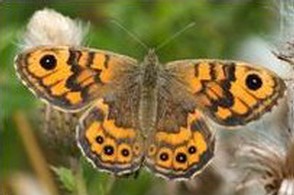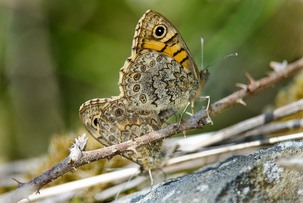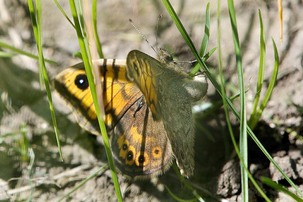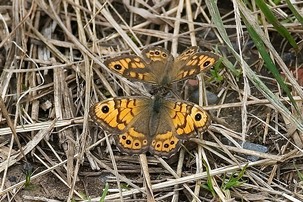

Biodiversity
Action
Plan
Wall Brown: A medium-sized, fast, strong and low flying, orange/brown butterfly. Restless by nature, males patrol alongside walls in search of females. The larger females are less active.
Colonies are found in areas of dry, unfertilised grassland and patches of bare stony ground or stone walls where this heat-seeking butterfly can bask in the sun. The Wall butterfly is mainly found west of Penistone in the farmed upland fringe.
Wall [Brown] Lasiommata megera
UKBAP Priority Species
S41 Species of Principal Importance
Red List: Near Threatened.
BC Conservation Priority: HIGH.
Protection
As a species of principal importance, the presence of the Wall is required to be taken into consideration for conservation by any public body when performing its functions. This includes avoiding sites with a colony for development and promoting their conservation and enhancement.
In Barnsley a site with a Wall colony is of sufficient priority to be designated a Local Wildlife Site which have a presumption against development requiring planning consent.

The colonies in Barnsley are mainly found on impoverished hillsides and on upland, long, linear, rough farm tracks, paths and bridleways alongside dry stone walls skirted with grasses.
Suitable habitat conditions occur where larval food plants grow including a variety of short grasses: Bents, Yorkshire-Fog, Tor Grass, Wavy Hair Grass, Purple Moor Grass and Cock’s-Foot, and where there are flowers such as Creeping Thistle, Bramble, Dandelion and Hawkweed for nectar.
The Wall benefits from patches of bare stony ground in a sunny, sheltered situation.
The Wall’s golden wings are marked with black/brown and white-pupilled eye-spots.
The wing undersides are beautifully patterned with a series of subtle and intricate patterns of grey/brown zig-zag stripes, eye-spots and markings.

A more numerous second brood occurs from late July to mid September. Exceptionally, in hot summers a partial third brood may occur. The larvae overwinter on grasses.
Conservation: Maintain unimproved grassland with no fertiliser enrichment and with access to larval foodplant grasses and nectar rich flowers and patches of bare or stony ground or stone walls.
Eggs are laid in dry grass or broken/slipped soil or turf. The larvae eat the tender grass.
There are usually two full generations a year, with adults usually flying from early May until the start of June.

For more information
UK Butterflies: Wall
Butterfly Conservation: Wall
Local Priority Habitats:
Dry Unimproved or semi-improved grassland; Acid Grassland/Heath mosaic; Open Mosaic on Previously Developed Land; Derelict Land in Built Environment

Pair of Wall butterflies showing ‘nose-bumping' behaviour
Wall Brown butterfly